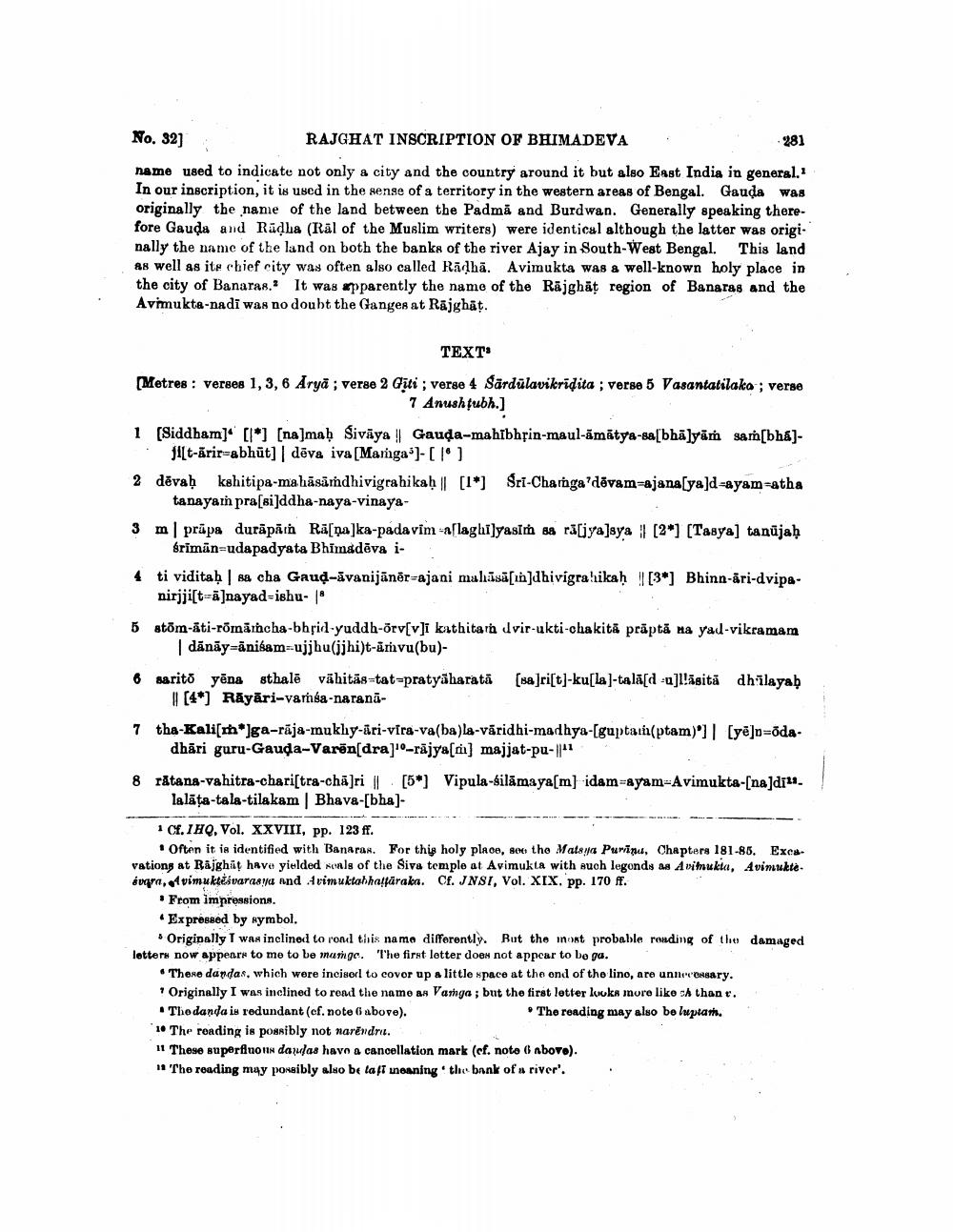________________
No. 32] RAJGHAT INSCRIPTION OF BHIMADEVA
281 name used to indicate not only a city and the country around it but also East India in general. In our inscription, it is used in the sense of a territory in the western areas of Bengal. Gauda was originally the name of the land between the Padma and Burdwan. Generally speaking therefore Gauda and Rüdla (Ral of the Muslim writers) were identical although the latter was origi. nally the name of the land on both the banks of the river Ajay in South-West Bengal. This land as well as its chief city was often also called Rādhā. Avimukta was a well-known holy place in the city of Banaras. It was apparently the name of the Räjghāt region of Banaras and the Avimukta-nadi was no doubt the Ganges at Rajghat.
TEXT:
(Metres : verses 1, 3, 6 Aryā; verse 2 Gīti ; verse 4 Sārdūlavikrīdita ; verse 5 Vasantatilaka ; verse
7 Anushubh.] 1 (Siddham]• [1] [na]mah Sivāya! Gauda-mahibhțin-maul-āmātya-sa[bhālyar sam[bháj
11[t-ärir=abhūt] | dēva iva (Manga). [1] 2 dēvaḥ kshitipa-mahāsāṁdhivigrahikaḥ || [l*) Sri-Chamga'dēvam-ajana[ya]d-ayam-atha
tanayam pra[si]ddha-naya-vinaya3 m prapa durāpā Rā[na]ka-padavim-allaghilyasim sa răsiya]sya | [2*] (Tasya] tanūjah
Sriman=udapadyata Bhimadēva i4 ti viditaḥ sa cha Gaud-āvanijānēr-ajani mahasā[in]dhivigrahikah !![3*] Bhinn-ari-dvipa
nirjjist=ā]nayad=ishu- * 5 stom-ati-römänncha-bhrid-yuddh-orv[v]i kathitará dvir-ukti-cha kita prăptă na yad-vikramam
dānāy=ānisam=ujjhu(jjhi)t-amvu(bu)6 sarito yēna sthalē vāhitās=tat-pratyāharatā (sa]ri[t]-ku[la]-talācd -u]lāsită dhilayah
II (4*) Rāyāri-vamsa-naran7 tha-Kali[]ga-rāja-mukly-iri-vira-vaba)la-vāridhi-madhya-[guptain(ptam)' [yējn=7da
dhāri guru-Gauda-Varēn[dra]'o-rājya[m] majjat-pu- ||"1 8 rātana-vahitra-chari[tra-chā]ri || [5*) Vipula-silāmaya[m] -idam=ayam-Avimukta-[na]diu.
lalāta-tala-tilakam Bhava-[bha)* Cf.IH. Vol. XXVIII, pp. 123 ff.
Often it is identified with Banaras. For this holy place, see the Matsya Purvīnu, Chapters 181-86. Excavations at Rajghat have yielded seals of the Siva temple at Avimukta with such legonds as Avitukta, Avimukte. svara, evimuktėávarasya and Arimuktahhaffäraka. Cf. JNSI, Vol. XIX. pp. 170 ff.
• From impressions. • Expressed by symbol.
* Originally I was inclined to rond this name differently. But the inost probable reading of the damaged letters now appears to me to be munge. The first letter does not appear to be ga.
* These dandas, which were incisorl to covor up a little space at the ond of the lino, are unneccesary. ? Originally I was inclined to read the name as Vanga ; but the first letter looks more like ch than r. . Thodanda is redundant (cf. note (above).
The reading may also bo luptat. 1. The reading is possibly not narēndre. 11 These superfluon damlas have a cancellation mark (cf. noto (above). 11 The roading may possibly also be la fi insaning the bank of a river'.




